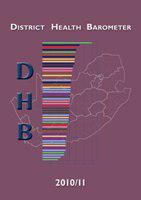Health Barometer shows slight progress

 The District Health Barometer (DHB) shows an improvement in the PCR testing coverage. PCR testing is done at six weeks on babies who are born to HIV-positive mothers. The number of babies getting tested has doubled to over 50% in the last two years. Out of those children who were tested, those found positive for HIV dropped from 7.5% to 3.6% last year. While a general improvement has been seen in HIV testing in ante-natal clinics, Limpopo province is in the lead.
The District Health Barometer (DHB) shows an improvement in the PCR testing coverage. PCR testing is done at six weeks on babies who are born to HIV-positive mothers. The number of babies getting tested has doubled to over 50% in the last two years. Out of those children who were tested, those found positive for HIV dropped from 7.5% to 3.6% last year. While a general improvement has been seen in HIV testing in ante-natal clinics, Limpopo province is in the lead.
‘Some of the districts at the top are three Limpopo districts that are above 100% testing. Some of that could be attributed to more women coming from neighbouring countries over and above the expected population. Then there are some other districts right at the bottom scoring 85%, which is not good enough but not bad for the country’, says Dr Tim Wilson of the Health Systems Trust (HST).
The Barometer also reveals that HIV and TB-related diseases are still the main causes of years of life lost (YLL). But there are other factors that result in years of life lost. Non-communicable diseases are on the rise.
‘TB and HIV are the main causes. Even if we are doing better on testing and curing the TB patients, they are still a concern. Transport injuries is right up there, strokes, hyper-tension and heart disease, inter-personal violence, diabetes, and ischemic heart disease. It is those non-communicable diseases that are coming up to bite us’, says Dr Wilson.
Overall, the TB cure rate has gone up to 70% from 50% in 2004, nationally. Three out of the nine provinces have shown dramatic improvement in their TB management programmes, namely, Kwa-Zulu Natal, Eastern Cape and the North West. The Barometer found that the burden of disease in the Greater Sekhukhune district, in Limpopo, is due to other communicable diseases, but less HIV and TB. In Ukhahlamba district, in the Eastern Cape, a much higher HIV and TB rate is reported.
‘Greater Sekhukhune is doing better at reporting the cause of death. The burden of disease there is communicable disease, and much less HIV and TB, but they also have more injuries. Years of life lost in Ukhahlamba district is TB and HIV, whereas in the other one diarrhoea and respiratory infections are the common things. The HIV prevalence is much higher in the Ukhahlamba district, the baby PCR coverage rate is higher here, the reported TB rate in that part of the Eastern Cape is 865 per 100 000 and in Greater Sekhukhune it’s 354. So, it is a massive difference’.
Dr Wilson says the high incidence of diarrhoeas in Limpopo is worrying, particularly in the Vhembe district.
‘Up North there is a huge amount of diarrhoea and some of that may be imported from neighbouring countries. It may be from people coming across for services because the kids are sick. But we need to interrogate it and see. The reality is that if you are sitting up in Vhembe you need to be looking carefully at diarrhoea management and how do we reduce the amount of diarrhoea in the district’.
He says the high incidence of diarrhoea in the Vhembe district could also be linked to access to quality water.
‘If you are living in Gauteng, then you have pretty good quality water. But you can see that there are some areas in the country where it is probably better to drink bottled water rather than tap water. To be able to link that to the incidences of diarrhoea, you can see now that up North the quality of tap water isn’t very good’.
Dr Wilson says a lot needs to be done to strengthen health and living conditions in many of the country’s districts in order to improve the health of the people.
Author
Republish this article
This work is licensed under a Creative Commons Attribution-NoDerivatives 4.0 International License.
Unless otherwise noted, you can republish our articles for free under a Creative Commons license. Here’s what you need to know:
You have to credit Health-e News. In the byline, we prefer “Author Name, Publication.” At the top of the text of your story, include a line that reads: “This story was originally published by Health-e News.” You must link the word “Health-e News” to the original URL of the story.
You must include all of the links from our story, including our newsletter sign up link.
If you use canonical metadata, please use the Health-e News URL. For more information about canonical metadata, click here.
You can’t edit our material, except to reflect relative changes in time, location and editorial style. (For example, “yesterday” can be changed to “last week”)
You have no rights to sell, license, syndicate, or otherwise represent yourself as the authorized owner of our material to any third parties. This means that you cannot actively publish or submit our work for syndication to third party platforms or apps like Apple News or Google News. Health-e News understands that publishers cannot fully control when certain third parties automatically summarise or crawl content from publishers’ own sites.
You can’t republish our material wholesale, or automatically; you need to select stories to be republished individually.
If you share republished stories on social media, we’d appreciate being tagged in your posts. You can find us on Twitter @HealthENews, Instagram @healthenews, and Facebook Health-e News Service.
You can grab HTML code for our stories easily. Click on the Creative Commons logo on our stories. You’ll find it with the other share buttons.
If you have any other questions, contact info@health-e.org.za.
Health Barometer shows slight progress
by ayandamkhwanazi, Health-e News
March 5, 2012
MOST READ
Cough syrup recall: What is diethylene glycol and what happens when you drink it?
Hunger and mental health: study looks at how families cope with food insecurity
Patients wait months for surgery at Leratong hospital as non-payment shuts down theatres
Social media for sex education: South African teens explain how it would help them
EDITOR'S PICKS
Related

Millions go hungry, accountability and public participation needed


